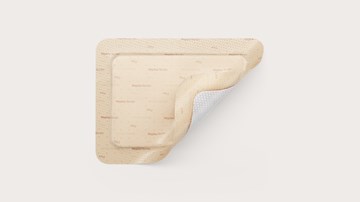Apósito de espuma todo en uno
Mepilex Border
Apósito autoadherente de cinco capas para heridas crónicas y agudas
Mepilex® Border es un versátil apósito de espuma todo en uno con bordes disponible en una amplia gama de formas y tamaños. Puede usarse para tratar heridas crónicas y agudas. Además, se ha demostrado clínicamente que ayuda a prevenir las úlceras por presión
Diseño exclusivo de cinco capas probado clínicamente con Safetac®, la capa de contacto original con silicona que minimiza el dolor. Safetac está diseñado para adaptarse suavemente a la piel sin adherirse al lecho húmero de la herida,
La capa de absorción atrae instantáneamente la humedad y el exudado, protegiendo la piel perilesional de la maceración
- Los apósitos con Safetac minimizan el dolor y el traumatismo en los cambios de apósito
- Versátil apósito todo en uno para una gran variedad de heridas crónicas y agudas
- Se ha demostrado que ayuda a prevenir úlceras por presión
- Excelente capacidad de retención de fluidos
para una gestión de exudado eficaz con menor riesgo de maceración - Menor traumatismo tisular
Más información sobre el producto
Cuándo utilizar Mepilex Border
Puede utilizar Mepilex Border para tratar una gran variedad de heridas crónicas y agudas exudativas y heridas secundarias. Nuestro apósito suave y adaptable mantiene el lecho húmedo de la herida, por lo que puede confiar en que absorbe y retiene el exudado eficazmente.
Puede elegir entre una gran selección de apósitos de distintos tamaños, adecuados para heridas pequeñas y grandes. También tenemos apósitos anatómicos para heridas localizadas en zonas específicas del cuerpo.
Mepilex Border también puede usarse como parte de un régimen profiláctico para ayudar a prevenir úlceras por presión
Puede volver a colocar Mepilex Border tras la evaluación de la piel.
Cómo utilizar Mepilex Border
Observe cómo aplicar el apósito de espuma todo en uno Mepilex Border.
Cómo funciona Mepilex Border
Vea cómo funciona Mepilex Border.
Datos del producto
| Ref. | Tamaño (cm) | Unidades/Caja | Unidades/TRP |
| 295200 | 7,5 x 7,5 | 5 | 70 |
| 295300 | 10 x 10 | 5 | 50 |
| 295000 | 12,5 x 12,5 | 5 | 50 |
| 295400 | 15 x 15 | 5 | 50 |
| 295410 | 17,5 x 17,5 | 5 | 35 |
| 295600 | 15 x 20 | 5 | 50 |
Productos relacionados
'References'

 Mepilex Border
Mepilex Border












